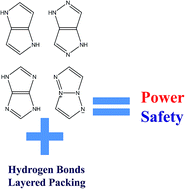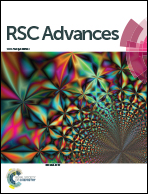A DFT study of five-membered nitrogen-containing fused heterocycles for insensitive highly energetic materials†
Abstract
A series of molecules with conjugated backbones combined with two five-membered nitrogen-containing rings is suggested for the design of new energetic compounds. With the participation of both –NH2 and –NO2, seven planar derivatives were characterized with aromaticity and intramolecular hydrogen bonds. The geometrical and electronic structures, gas and condensed-phase heats of formation (HOFs) and strengths of the hydrogen bonds were studied using density functional theory methods. The crystal structures of these compounds were predicted using molecular packing calculations. The bond dissociation energies (BDEs) were investigated to understand their stabilities. Our calculated results indicate that these compounds are promising candidates for energetic materials. Among them, two compounds with a B4 backbone, B4-1 and B4-2, possess high densities, great HOFs and detonation properties. B4-2 has not only a high density of 2.263 g cm−3, heat of formation of 106.91 kcal mol−1, detonation velocity of 9.74 km s−1 and pressure of 47.79 GPa, but also a high BDE of 62.72 kcal mol−1 and layered crystal packing, and can be considered as a potential candidate for high energetic materials with great insensitivity.


 Please wait while we load your content...
Please wait while we load your content...